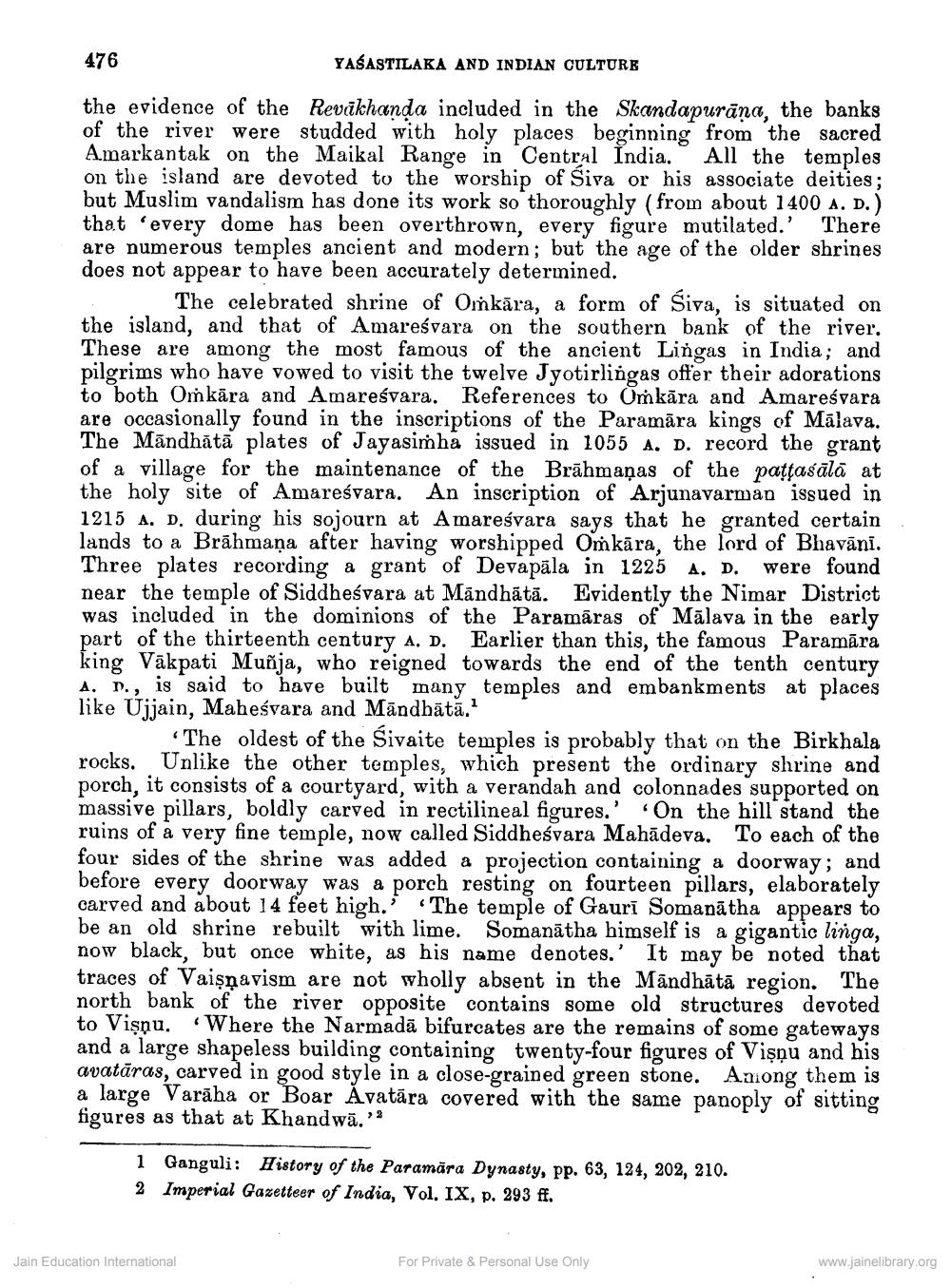________________
476
YASASTILAKA AND INDIAN CULTURE
the evidence of the Revükhanda included in the Skandapurāna, the banks of the river were studded with holy places beginning from the sacred Amarkantak on the Maikal Range in Central India. All the temples on the island are devoted to the worship of Siva or his associate deities; but Muslim vandalism has done its work so thoroughly (from about 1400 A, D.) that 'every dome has been overthrown, every figure mutilated.' There are numerous temples ancient and modern; but the age of the older shrines does not appear to have been accurately determined.
The celebrated shrine of Omkāra, a form of Siva, is situated on the island, and that of Amareśvara on the southern bank of the river, These are among the most famous of the ancient Lingas in India, and pilgrims who have vowed to visit the twelve Jyotirlingas offer their adorations to both Omkāra and Amareśvara. References to Omkāra and Amareśvara are occasionally found in the inscriptions of the Paramāra kings of Mālava. The Māndhātā plates of Jayasimha issued in 1055 A. D. record the grant of a village for the maintenance of the Brāhmaṇas of the patjaśālā at the holy site of Amareśvara. An inscription of Arjunavarman issued in 1215 A, D, during his sojourn at Amareśvara says that he granted certain lands to a Brāhmaṇa after having worshipped Omkāra, the lord of Bhavani. Three plates recording a grant of Devapāla in 1225 A. D. were found near the temple of Siddheśvara at Māndhātā. Evidently the Nimar District was included in the dominions of the Paramāras of Mālava in the early part of the thirteenth century A. D. Earlier than this, the famous Paramāra king Vākpati Muñja, who reigned towards the end of the tenth century A. P., is said to have built many temples and embankments at places like Ujjain, Maheśvara and Mändbätä.
The oldest of the Sivaite temples is probably that on the Birkhala rocks. Unlike the other temples, which present the ordinary shrine and porch, it consists of a courtyard, with a verandah and colonnades supported on massive pillars, boldly carved in rectilineal figures.' On the hill stand the ruins of a very fine temple, now called Siddheśvara Mahādeva. To each of the four sides of the shrine was added a projection containing a doorway; and before every doorway was a porch resting on fourteen pillars, elaborately carved and about 14 feet high.' The temple of Gauri Somanātha appears to be an old shrine rebuilt with lime. Somanātha himself is a gigantic linga, now black, but once white, as his name denotes.' It may be noted that traces of Vaisnavism are not wholly absent in the Māndhātā region. The north bank of the river opposite contains some old structures devoted to Vişnu. Where the Narmadā bifurcates are the remains of some gateways and a large shapeless building containing twenty-four figures of Vişņu and his avatāras, carved in good style in a close-grained green stone. Among them is a large Varāha or Boar Avatāra covered with the same panoply of sitting figures as that at Khandwā.'
1 Ganguli: History of the Paramāra Dynasty, pp. 63, 124, 202, 210. 2 Imperial Gazetteer of India, Vol. IX, p. 293 ff.
Jain Education International
For Private & Personal Use Only
www.jainelibrary.org




